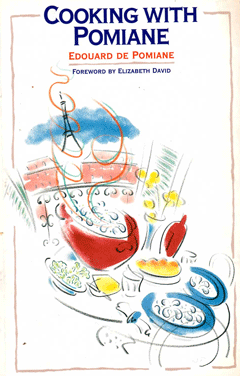Elizabeth David was a fan of Pomiane; in fact she wrote the introduction to this edition, beginning “I love Docteur de Pomiane’s work. In fact I owe him a great debt.” She likes him because he doesn’t just give us instructions, but explains why: “He has made us understand our actions. We know what we have done right — it is just as important — as well as where we may have gone wrong.”
This is a neglected cookbook, but Pomiane is an entertaining writer, and his recipes are often accompanied by anecdotes. When I read the introduction to Poulet Tamara, I was immediately captivated.
According to a story denied by some Georgians, the country was ruled in the twelfth century by Tamara, a queen of rare beauty who, having cast out her drunken husband, the Muscovite prince Bogolubski, decided to drive her lover, the poet Rousthaveli, author of the marvellous poem The Leopard Skin, mad with jealousy. To inflame the passions of the wretched man she took lovers at random, welcoming them in her castle on a crag above the Georgian highway over the Caucasus, and preparing with her own hands the principal dish of the banquet she offered them. The chance lover was overwhelmed with wine and caresses. Next morning he was hurled to his death over a precipice which one can see to this day.
This dish is the one Tamara served to her doomed guests, and Pomiane promises “a completely novel gastronomic sensation”. Having already experienced one of these in the form of his wonderful tomates à la crème, I quickly scanned the recipe to check that I had all the ingredients. It looked like an excellent way to use up the leeks, turnips, onions and carrots in the veggie box, and I had some walnuts that needed using too, so the decision was made.
But oh Docteur Pomiane, how you deceived me! Put the chicken in a heavy casserole with the onions, carrots and leeks, the herbs and spices, and some water, he tells us. So I duly did. Then looking at the next step, I find he’s now telling me to finely chop the onions and garlic that are currently happily simmering with the chicken, and soften them in butter as the first step in making the sauce. Oh well, I’ll chop another onion. But wait … now I read the recipe more closely and discover that the turnips in the ingredients list are never mentioned again. Hmm, maybe they were supposed to go in with the chicken, instead of the onions? But won’t they make the sauce taste of turnip? Too late now anyway — I’ll just have to eliminate them from the recipe.
So I can’t really claim that what I ended up with is exactly what Tamara served to her lovers. Basically you poach the chicken with vegetables (possibly including turnips) for half an hour, then remove the chicken and roast it for another half hour. The strained stock from the poaching is reduced and used to thin a sauce made of fried onions and garlic, pounded walnuts, vinegar, and egg yolks. Theoretically you pour the sauce over the cut-up chicken, leave it to stand overnight, and eat it cold, but after a day’s mountain walking Steve didn’t seem keen on waiting till breakfast time to eat his dinner. So we ate it hot.
The sauce was … interesting, but really not an attractive colour — a greyish pink. Still, roast chicken is roast chicken, so it wasn’t a total failure. And the vegetables and stock will make a nice soup — maybe I’ll even add the turnips.
This hasn’t put me off Pomiane anyway — it’s probably just a result of poor copy-editing. The book includes a lot of simple, homely French classics, including a reliable recipe for gratin dauphinois which illustrates his talent for explaining the “why”. He mentions three different ways of cooking it, and then explains why his method, which involves adding a tiny amount of flour to the cream, is the best: it prevents the cream from separating.
Finally, like Elizabeth David’s, his prose is a pleasure to read for itself, even if you aren’t planning on cooking anything.
